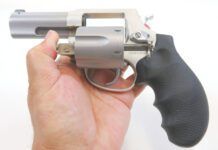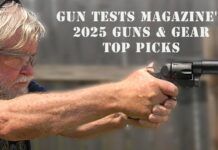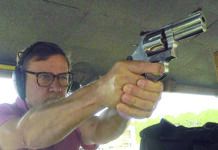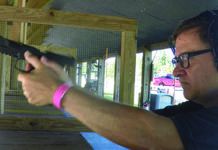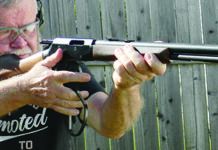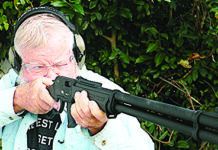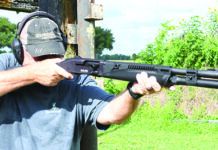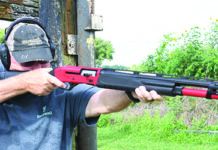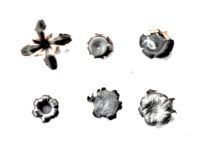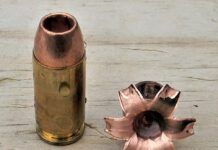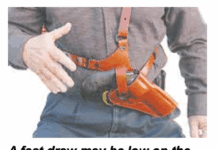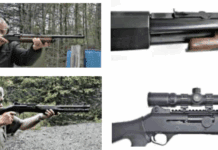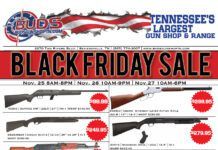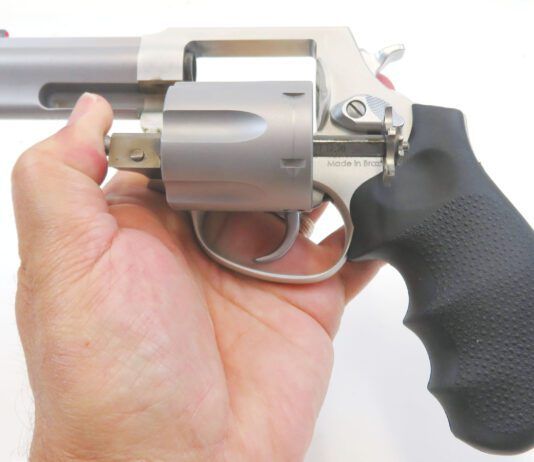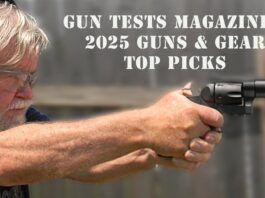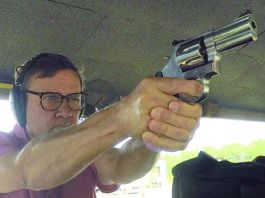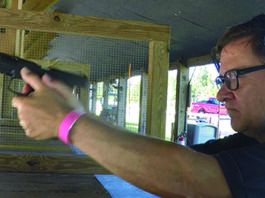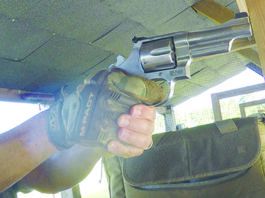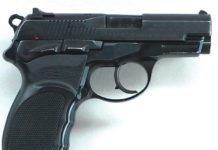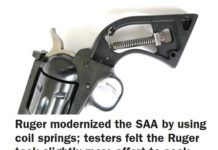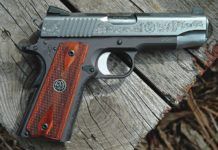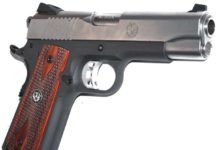Bersas UC Thunder Pro Versus S&Ws 908
When it comes to personal defense, handgun owners have many strong preferences — cultural, generational, or even institutional. Former peace officers may prefer a pistol similar to the service gun they carried at work, and soldiers often choose a Beretta because they got used to feel of an M9. One of these preferences is for a double-action first-shot handgun, which some Gun Tests readers have mentioned in comments to the editor. While personal preferences are important and heft and feel mean a lot in concealed carry, the subjective cannot outweigh objective features. The handgun must exhibit good reliability, safe operation, and practical accuracy.
Two such handguns chambered in 9mm Luger we hoped would produce these qualities were a Smith & Wesson 908 and a Bersa 9mm. The Bersa has been known as the Mini Firestorm or the Bersa Pro, and is currently named the Thunder Pro Ultra Compact. We previously had tested (May 2006) a full-size Bersa Thunder 9 and said "Buy It." We liked the workmanship, looks, feel, and performance of the 18-shot Bersa. Further, "If you want or need a good DA/SA nine that will shoot from dawn to dusk on one loading, this is an excellent choice, we thought. The gun looked about as good inside as it did out, and that inspired confidence." In that review, we also mentioned "a smaller overall version…," which is the Thunder Pro Ultra Compact. The current iteration of this handgun has a slightly different trigger guard shape, and it has a rail slot for a light or laser, but is functionally similar to our used sample. New, the 9mm comes in either a matte-black finish like our used test gun or a duotone version. There are also 45 ACP and 40 S&W chamberings in both finishes. We paid $300 for our test gun, and a new matte-black 9mm Thunder Pro UC was listed for $402 at CheaperThanDirt.com and $407 regular retail and $395 cash price at BudsGunShop.com — so around $100 more.
In the January 2005 issue, we reviewed a Smith & Wesson 908S Carry Combo against a Kahr TP9 and Kel-Tec P11. The 908S earned an "Our Pick" rating in that test, which would translate to an A grade today. Our test gun here is the blued version, the 908, which we haven't tested previously. The 908 was produced from 1996-2006. The stainless 908S was manufactured from 2003-2006. We paid $350 for our used 908, but we have seen them listed for $50 less.
To conduct combat firing, we loaded the Winchester 115-grain full-metal-jacket rounds. Our shooters drew the pistols from a Rinehart Leather belt-slide holster (RinehartLeather.com). The drills began with a pistol fully loaded and hammer down with the safety on. We fired the first shot double action and transitioned, firing the remainder of the group single action. It was not difficult to make center hits at 5, 7, and 10 yards with either handgun. But we did have a preference, which we express below:
Convertible Flattops: Lipseys Blackhawk and New Frontier
Colt started to put adjustable sights on its single-action revolvers around 1890 to fill a need for target shooters. Most single actions of the day, and, in fact, to the present, feature simple fixed sights; a blade front and rear consisting of a groove milled along the top strap. These sights suffice for most shooters, though some Kentucky windage and elevation are required with some models that did not shoot to point of aim. Adjustable sights take out the guesswork since they can be adjusted to any load being fired. Colt named the single action with adjustable sights the Flattop Target Model, and these First Generation revolvers were shipped from 1888 to 1896 with fewer than 1,000 made. Obviously, they are quite rare. Bisley models were also offered as Flattop Target Models, and even fewer of these models were produced. What these first Flattop revolvers featured was a replaceable front-sight blade to adjust elevation and a rear sight that was drift-adjustable for windage. Since the rear sight groove was not needed, the top strap of the frame was machined, flat hence the name "Flattop."
The two flattops we tested recently were a used Third Generation Colt New Frontier and a new Lipsey's exclusive Ruger New Model Blackhawk. Both wore aftermarket grips, and from outward appearances, looked nearly identical. What piqued our interest in these two revolvers was they were also convertibles with an extra cylinder. One cylinder was chambered in 45 Colt (sometimes called Long Colt to ensure it doesn't get confused with a shortened pronunciation of Automatic Colt Pistol) and the other was chambered in 45 ACP. Both cartridges are very popular, and 45 ACP made these six-shooters compatible with ammo normally used in a semi-automatic pistol.
The operating systems of each revolver are what distinguish them. The New Frontier is an old-school single action with no built-in safety, so it must be carried with the hammer resting on an empty chamber to guard against discharges if dropped. The Ruger New Model Blackhawk incorporates a transfer-bar safety mechanism that allows the revolver to be carried with all chambers loaded. The Colt uses a flat mainspring and flat springs throughout, and the Ruger uses a coiled mainspring as well as coiled springs throughout.
We used a revolver range rod and rod head combo from Brownells in 45 Auto/45 Colt (080-617-045WB, $42) to check each chamber for alignment with the bore. We found no issues. Next we looked at headspace—the space between the recoil shield of the frame and the rear of the cylinder—and assumed all would be fine since the Ruger was new the Colt looked unused. Again, our assumption was confirmed with Clymer No-Go gauges from Brownells in 45 Auto (184-000-041WB, $60) and 45 Long Colt (184-100-511WB, $30). Both cylinders for both revolvers have non-rebated cylinders. The headspace check process was a bit different for each revolver. For the Colt, we put the hammer on half-cock and opened the loading gate; for the Ruger, we just had to open the loading gate and drop the No-Go gauge into a chamber. If correct, the gauge stops the cylinder's rotation. This was repeated with all 24 chambers;12 for both 45 Colt cylinders and 12 for the two 45 ACP cylinders. With the Colt, the No-Go gauge is removed only after removing the cylinder. The process is tedious, but it's warranted to ensure the safety of a used revolver. The Ruger has a reversing pawl, like Ruger's Vaquero models, so the process is quicker. So is unloading the Ruger, but we'll get to that. Finally, we checked the cylinder-to-barrel space, aka cylinder gap, using a Brownells feeler gauger (606-950-252WB, $28). The space should spec out between 0.004 to 0.006 inch. We found the dimension on the Colt was 0.007 inch for each cylinder. On the Ruger, the 45 Colt cylinder gap measured 0.005 inch and the 45 ACP cylinder was 0.006 inch.
With the pistols all checked out, we were then able to get to the fun part and begin shooting them. Here's how that went:
Upgrading Rugers Commander
Readers will recall our May 2015 test of Ruger's new SR1911 CMD-A, a Grade A lightweight Commander-style 45 auto. To sum up that test, we consider the new Ruger lightweight Commander-type auto to be one of the finest self-defense handguns available today. The gun has just what it needs and no extra nonsense. It has excellent sights. It does not have a firing-pin block, nor a full-length guide rod, which some of us despise. That means you can take the gun apart easily with no tools. The slim and attractive wood grips seem to be an aid to pointing the gun, and also contribute to concealment. We found the two-tone finish appealing, and the factory dehorning was mighty good. The original trigger pull was very much acceptable, as was the accuracy. The integral plunger housing cannot come loose. Finally, those with fat hands will like the full-size grip of the LW Ruger better than the shorter one on guns like the Colt CCO. It makes for a better grip, and speed reloading is easier.
But even good products like the CMD-A can be improved, so Senior Technical Editor Ray Ordorica bought it for himself with an eye toward making it resemble his Colt CCO. He slicked the Ruger up, included beveling the front of the frame, eliminating all the sharp edges around the ejection port, knocking the sharp bottom off the mainspring housing, removing metal from under the trigger guard to get the hand higher, checkering the front strap, and rounding the sharp edges at the sides of the grip safety. The steel parts were reblued as needed with Formula 44/40 Instant Gun Blue, and the aluminum parts were reblackened with Aluminum Black, both available from Brownells. And as the previous photo shows, he engraved the gun.
One of the main performance goals was to improve the Ruger's already good trigger pull, so he contacted master gunsmith Ned Christiansen at Michiguns and asked about getting a trigger job. Instead, Christiansen recommended we try an "ignition set" offered by John Harrison (HarrisonCustom.com). Harrison offers a complete line of gunsmithing services along with a not-quite-drop-in kit called the Harrison Custom HD-120-TR Extreme Service Ignition Package, Strut, and Trigger, $186. We chose the carbon-steel version in white, though the parts are also available with a black coating or of stainless-steel construction. At Harrison's suggestion, we opted for the True Radius sear, which has its contacting surface ground on an arc centered on the pivot pin. He also sent along a hammer strut and a replacement trigger a bit shorter than the Ruger's. Our task was to fit all the parts and see what dropped in and what did not, and of course evaluate the products. Here is what we found.
Kel-Tec PMR 30 Review
When Kel-Tec CNC Industries brought out its PMR-30 semi-auto pistol chambered in 22 Winchester Magnum Rimfire, we immediately wanted to compare it to FN's 5.7, a much more expensive handgun. Also, the FiveSeven was chambered in 5.7x28mm, a much more expensive and hard to find round.
Ruger GP100 Match Champion 357 Magnum Revolver Review
Ruger GP100 Match Champion No. 1754 357 Magnum, $899
The Ruger GP100-series revolvers are different from the Smith & Wesson 686s, but both guns were introduced to provide more durability than previous models.
The Ruger GP100 replaced the Security Six revolver in about 1986 with innovations such as stronger lockup built into the cylinder crane rather than at the tip of the ejector rod. Another feature that adds strength to the GP100 design is the lack of side plates in the construction of the frame.
FN 5.7 Handgun Review
In an intriguing and extensive match-up in the December 2014 issue, Gun Tests Magazine pitted two handguns chambered for hot 22-caliber bottlenecks against each other. The 22 TCM and the 5.7x28mm cartridges are interesting on many levels, but also are not the most common or easily obtained rounds. Both handguns have a military heritage, but the Rock Island 1911 is pretty far removed from its 1911A1 45 ACP ancestor.
Tactical 1911 Pistol Shoot Out: SIG Sauer Vs. Smith & Wesson
The 1911 handgun has survived for more than one hundred years based on excellent ergonomics, great reliability, and its ability to chamber a fight-stopping cartridge. Modern 1911 handguns are much evolved from the Colt 1911 first issued to Army troops in 1911. However, a doughboy going to Europe in 1917 would be able to instantly load, make safe, fire and use a modern 1911 handgun. The ability of the platform to accept a weapon-mounted light was an inevitable part of the 1911's evolution, because a gun-mounted combat light is a good tactical addition. They allow for the identification of a threat, illumination of an area, and make fail-safe identification possible.
Two so-equipped full-size 1911s are the SIG TACOPS and the Smith & Wesson 1911TA E Class. The SIG Sauer 1911 TACOPS 1911R-45TACOPS, $1213 list, is a no-nonsense black tactical pistol. We found it at DefenderOutdoors.com for $1,080, at BudsGunShop.com for a cash discount price of $1,062, and for $910 at GrabAGun.com. Our test gun is part of the larger SIG 1911 family, which at our last count, had 31 members. Generally speaking, SIG 1911s have done very well in our evaluations. In the October 2014 issue, we graded a 1911 Carry Scorpion 1911CAR-45-SCPN as a B+. In the November 2013 issue, a 1911 Carry Stainless 1911CA-45-SSS earned an A- grade and a "Best Buy" nod. In the February 2009 issue, a 1911 C3 No. 19GS0031 earned an A grade. In the May 2006 issue, a Sigarms 1911 GSR No. 19GS0001 earned a Conditional Buy, mainly because of its price, not its functionality. We'd translate that to a B+ today.
S&W's SW1911 "E" Series pistols are supposed to be "enhanced, with tight tolerances, precision-fit trigger, chamfered and recessed muzzle, "fish-scale" scalloped slide serrations and other premium features commonly found on custom-made firearms. The standard E-series 1911s come in blued or stainless steel, and the model number with "SC" appended have scandium-alloy frames. The blued version we tested is #108409, while the stainless model is #108411. List for our test gun is $1399, and we saw it for sale at DefenderOutdoors.com for $1140, TombstoneTactical.com for $1099, and at BudsGunShop.com for $1065.
Smith 1911s have not matched SIG's level of performance in our tests. In the April 2010 issue, the S&W Model SW1911 No. 178017 in 9mm got a B+. A 45 ACP Smith & Wesson MSW1911 No. 108284 earned a B+ in the February 2010 issue. In March 2006, a 1911SC No. 108289 got a "Don't Buy" rating, as did a 1911PD No. 108296 tested in the November 2005. Way back in April 2003, we tested the first-year version of the company's 1911 and said "Buy It" to a Smith & Wesson 1911 45 ACP.
But history isn't necessarily destiny at Gun Tests. Out of the box, the Smith & Wesson had more bling and eye appeal, no denying that. And at the heart of each pistol was a tight barrel-to-slide fit, which provided X-ring accuracy without sacrificing reliability. Just like you, we prefer to shoot good guns, and what we found here were two pretty good ones, though our team had its preference at the end.
Rugers Lightweight Commander
Colt still makes the Lightweight Commander (O4860XSE, $1104), but no longer makes one of our favorite carry guns, the CCO, or Colt Concealed Officer's model. We thought this Ruger looked enough like the Colt CCO that a comparison was in order. In this first-look report, we take a good look at the new Ruger and briefly see how it stacks up to a custom CCO on hand.
We shot the Ruger with 230-grain FMJ "hardball" by Black Hills and Winchester, Winchester's 200-grain BEB, and with Federal 185-grain JHP Hi-Shok. We tried a few rounds of Cor-Bon 185-grain JHP, but found the recoil to be much too fierce. Here's what we found from our first look at the new Ruger.
Video: March 2015 SIG P320 Review
The SIG Sauer P320 is a credible handgun, but we found it lacking in important areas. The trigger is OK for a service pistol, but most of us would like a lighter trigger for better accuracy. But the SIG trigger doesn't have a safety lever, so it would not be wise to offer a lighter trigger without re-engineering it. The P320 also wasn't as friendly to diverse hand sizes as were the other guns. Finally, the P320 was the largest and heaviest pistol tested, which works against it as a personal carry sidearm.
(Gunsmithing Pistols and Revolvers #4) Cold Blue
Cold bluing, or chemical bluing, is used to touch-up slightly worn or nicked blued finishes. It is suitable for covering up the holster wear on the muzzle of a revolver, or a spot on a slide where your sweat lifted the blue. It is not nearly as durable as a hot-dip blue finish. Some cold-blue formulas contain sulfides, and a handgun that has been touched-up too much can have a very alight, but noticeable, smell of rotten eggs. Sniffing a used firearm, to see if there has been any use of cold blue to hide wear, is an old trick in the gun business.
(Gunsmithing Pistols and Revolvers #5) Reassembly Tips – Smith & Wesson
When putting an S & W revolver back together, a few steps seem to cause more trouble than the rest. One is the insertion of the cylinder-locking bolt, and its spring, into the frame. The bolt has to go down its shaft, while the spring has to be squirmed back into the tunnel drilled into the front of the frame cutout. (I have no idea how they drill that hole.) With the frame resting on a padded surface, place the spring into its hole in the locking bolt. Start the bolt partway down the shaft until the spring bears against the edge of the frame. Use a small eyeglass screwdriver to compress the spring enough to clear the edge of the frame and push the bolt and spring down the shaft. When you get to the frame hole, the spring will snap into place. Be sure the bolt is completely down the shaft, and pivots smoothly up and down through the cutout under the cylinder.
Light-Recoil 45 ACP Loads
The road in life isn't always straight and narrow. It can be winding and even out of control. Some changes are unwelcome, even fearful. Among the significant changes as we age is a loss of muscle mass. Shooters who once handled hard-kicking handguns now find them ever more difficult to handle. Arthritis and a culmination of old injuries make firing the big-bore pistol difficult. These individuals, along with young shooters who have adopted a lightweight pistol such as a Colt Commander, and slightly-built female shooters interested in a low-recoil load, are faced with difficult decisions. Once the decision is made to take advantage of the big-bore 45 ACP handgun, shooters are seldom willing to back down to the 9mm.


